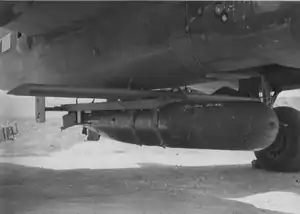| GT-1 | |
|---|---|
 GT-1 glide torpedo mounted on North American B-25J Mitchell medium bomber | |
| Type | Air-to-surface missile |
| Place of origin | United States |
| Service history | |
| In service | 1944-1945 |
| Used by | United States Army Air Forces |
| Production history | |
| Designed | 1942-1943 |
| Manufacturer | Aeronca |
| Specifications | |
| Wingspan | 12 feet (3.7 m) |
| Warhead | Mk 13 Mod 2A aerial torpedo |
| Warhead weight | 600 pounds (270 kg) explosive |
| Engine | None |
Operational range | 25 miles (40 km) |
| Maximum speed | 260 miles per hour (420 km/h) |
Guidance system | Preset plus paravane |
Launch platform | B-25 Mitchell |
The GT-1 (Glide Torpedo 1) was an early form of stand-off weaponry developed by the United States Army Air Forces during World War II. Intended to deliver an aerial torpedo at a safe range from the launching aircraft, the weapon proved successful enough in testing to be approved for operational use, and the GT-1 saw limited use in the closing stages of the war.
Design and development
The GT-1 was derived from the GB-1 series of glide bombs, developed by Aeronca for the United States Army Air Forces.[1] The weapon's airframe was inexpensive and simply designed, with a basic wing and twin tails attached to a cradle for carrying the payload.[1] The flight path of the GT-1 was determined by a preset autopilot that kept the weapon on a steady course after release.[1]
The GT-1 was usually released from its carrier aircraft at an altitude of 10,000 feet (3,000 m); this provided a standoff range of as much as 25 miles (40 km) under ideal conditions.[2][3] The GT-1's warload consisted of a Mark 13 Mod 2A aerial torpedo. The GT-1 was fitted with a paravane, trailing 20 feet (6.1 m) below the main body of the craft; upon the paravane's striking the surface of the water, explosive bolts would fire to release the torpedo, which would then execute a preset search pattern to locate and destroy its target.[1][2]
Operational history
Initially tested during 1943,[1][4] the GT-1 proved to be successful,[5] and was issued to a single operational unit for service.[6] Launched from North American B-25 Mitchell bombers,[1][7] the GT-1 saw brief operational service late in the war;[1][4] three missions are known to have been flown using the weapon from Okinawa in late 1945.[7] On one mission, against Kagoshima, eleven of thirteen GT-1s launched successfully entered the water; three hits were recorded, against a fleet carrier, a light carrier, and a freighter.[7] The Boeing B-17 Flying Fortress was also capable of carrying the GT-1.[3]
Following the end of World War II, the aerial torpedo rapidly fell out of favor as a weapon of war against surface ships, and the 'GT' category of weapons was abolished in 1947.[8]
See also
References
| External videos | |
|---|---|
Notes
Bibliography
- Craven, Wesley F.; James L. Cate (1958). USAF Historical Division (ed.). Men and Planes. The Army Air Forces in World War II. Vol. 6. Chicago: University of Chicago Press. ASIN B000ZIBK5G.
- Daso, Dik A. (1997). Architects of American Air Supremacy: General Hap Arnold and Dr. Theodore von Kármán. Maxwell Air Force Base, AL: Air University Press. ISBN 9781585660421. Retrieved 2011-02-02.
- Goebel, Greg (2010). "World War II Glide Bombs". Dumb Bombs & Smart Munitions. VectorSite. Retrieved 2017-05-14.
- Hanle, Donald J. (January 2011). "Hail November". Air Force Magazine. 94 (1). Retrieved 2011-02-02.
- Mann, Robert A. (2008). Aircraft record cards of the United States Air Force: How to Read the Codes. Jefferson, NC: McFarland & Company. ISBN 978-0-7864-3782-5. Retrieved 2011-02-02.
- Parsch, Andreas (2003). "GB Series". Directory of U.S. Military Rockets and Missiles Appendix 1: Early Missiles and Drones. designation-systems.net. Retrieved 2011-02-02.
External links
 Media related to GT-1 at Wikimedia Commons
Media related to GT-1 at Wikimedia Commons